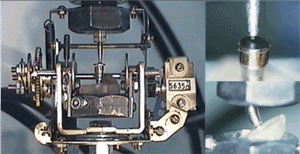 A hexagonally shaped abutment, with or without modification, can be used in different clinical applications. A prefabricated castable coping designed to fit the hexagonal shape of the abutment and its shouldered margin was cemented to a hexagonal abutment. Pullout tests were used to evaluate retentive strength of the cemented coping in unmodified and modified forms. The unmodified hexagonal abutment with 3mm high parallel walls produced the highest retentive strength. Removal of one of the hexagonal surfaces maintained 80% of the retentive strength. Further removal of the second and third adjacent surfaces produced no significant reduction in retentive strength. Removal of the remaining three surfaces produced a cylindrical abutment, which demonstrated the weakest retentive strength. A hexagonally shaped abutment, with or without modification, can be used in different clinical applications. A prefabricated castable coping designed to fit the hexagonal shape of the abutment and its shouldered margin was cemented to a hexagonal abutment. Pullout tests were used to evaluate retentive strength of the cemented coping in unmodified and modified forms. The unmodified hexagonal abutment with 3mm high parallel walls produced the highest retentive strength. Removal of one of the hexagonal surfaces maintained 80% of the retentive strength. Further removal of the second and third adjacent surfaces produced no significant reduction in retentive strength. Removal of the remaining three surfaces produced a cylindrical abutment, which demonstrated the weakest retentive strength.
Clinically, selective removal of three adjacent surfaces on the hexagonal abutment allows its use in multiple implant bridge construction. The maximum allowance for non- parallelism in any direction for each implant is 15 degrees. In single implant restoration when the abutment margin is subgingival, the crown itself can be angulated to achieve emergence profile. parallelism in any direction for each implant is 15 degrees. In single implant restoration when the abutment margin is subgingival, the crown itself can be angulated to achieve emergence profile.
The concept of using different abutments for different types of prosthetic applications needs to be challenged. A standardized abutment with prefabricated coping can greatly simplify not only treatment planning but prosthetic protocol in implant dentistry.
1. Assif D, Azoulay S, Gorfil G. The degree of zinc phosphate cement coverage of complete crown preparations and its effect on crown retention. J Prosthet Dent 1992;68:275-278.
2. English CE. Externally hexed implants, abutments, and transfer devices: A comprehensive overview. Implant Dent 1992;1:273-282.
Supported in part by the National Research Council of Canada #28048U
|